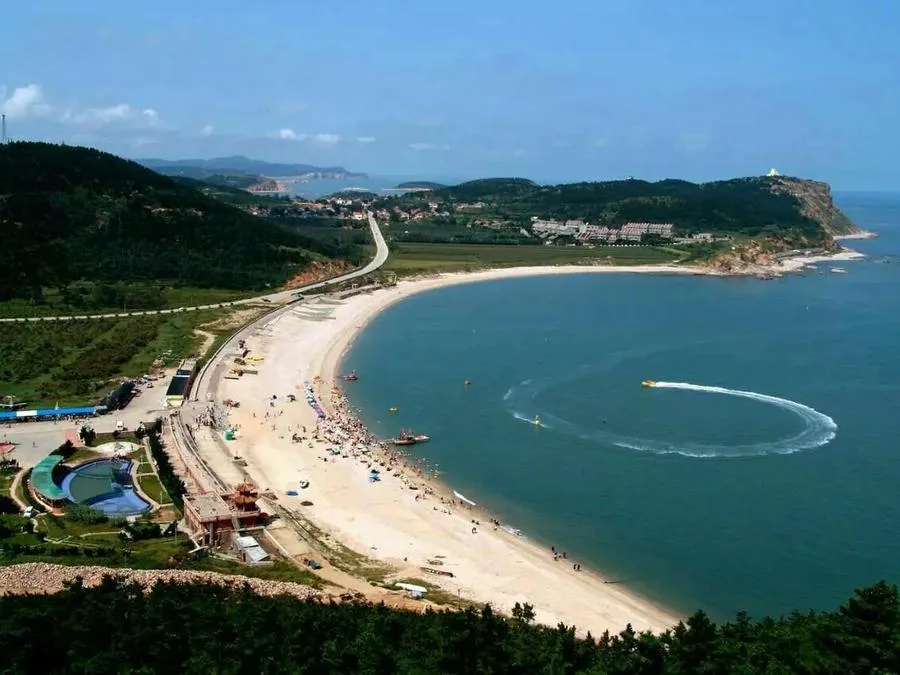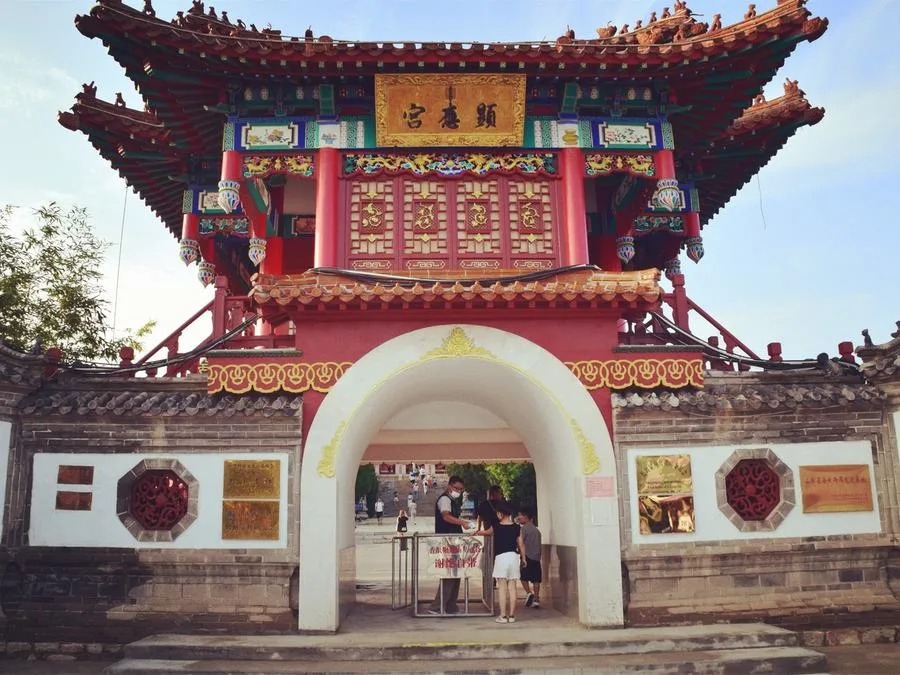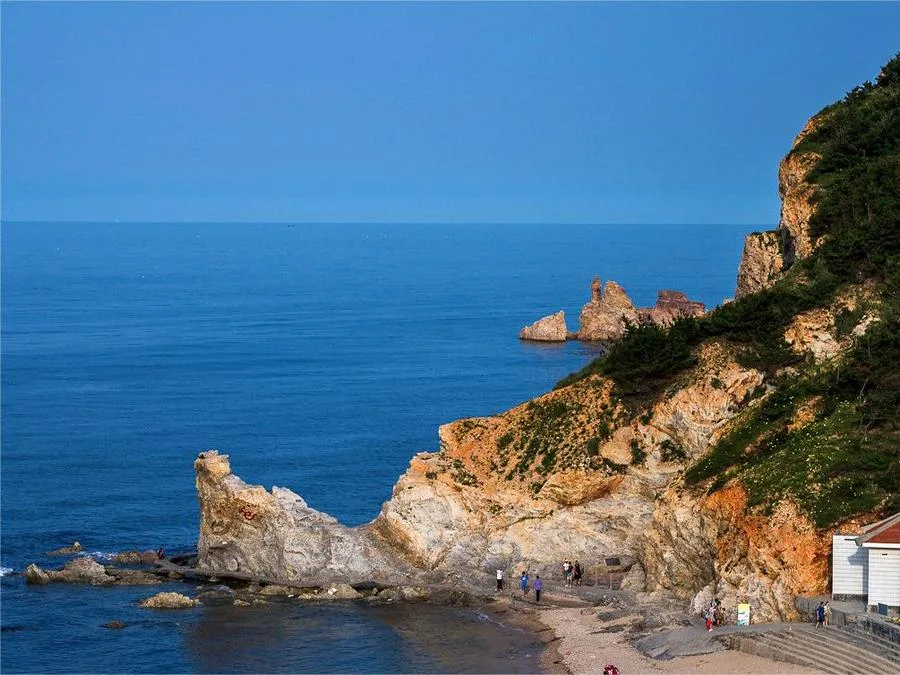Changdao Island (长岛), also known as the Chang Island or Miaodao Islands, comprises 32 islands, 66 reefs, and an extensive maritime area of 8,700 square kilometers. Of these, 10 islands are inhabited. As the only island county in Shandong Province, Changdao is strategically located between the Jiaodong and Liaodong Peninsulas. The region boasts a pleasant climate, picturesque landscapes, and abundant cultural resources, making it an ideal destination for tourism and summer retreats.
Exploring Changdao often involves island hopping. The southern route features attractions such as Linhai Park, the Yellow and Bohai Sea Convergence Line, Fuyun Pavilion, Fengshan Park, and Fairyland Source. The northern route includes sites like Jiuzhangya Cliff, Crescent Bay Park, Wangfu Reef, and the Geological Museum. A unique aspect of Changdao’s scenery is the presence of large white wind turbines, visible from nearly any part of the island, which have become an integral part of its landscape.
While it is possible to visit the main attractions of Changdao in a single day, to fully experience the island’s charm and beauty, it is recommended to stay overnight.
Table of Contents
- Basic Information
- Location and Transportation
- Highlights of Changdao Islands
- Vlog about Changdao Island
- Attractions near Changdao Island
Basic Information
| Estimated Length of Tour | 1 – 2 days |
| Ticket Price | The Whole Area: 150 RMB Northern Route: 110 RMB Southern Route: 110 RMB Ticket Valid for 3 Days |
| Opening Hours | 8.30 – 17.30; Last admission: 17.00 |
| Telephone Number | 0086-0535-3216568 0086-0535-3099789 |
Location and Transportation
The Changdao Islands are situated between the Jiaodong and Liaodong Peninsulas at the confluence of the Yellow Sea and the Bohai Sea. They lie in the connection belt of the Bohai Economic Rim, facing South Korea and Japan to the east.
- Getting to the Islands:
- To reach Changdao, you must first travel to Penglai. From the Penglai Wharf (蓬莱码头), you can take a passenger ferry to the islands.
- On the Islands:
- Car Rental: While taxis are available on the islands, renting a car can be more cost-effective for visitors traveling between various attractions.
- Bicycle Rental: Many local fishing households offer bicycles for rent. If your schedule allows for a leisurely exploration, renting a bicycle is a great way to enjoy the scenic beauty of the islands.
Highlights of Changdao Islands
Jiuzhangya Cliff

Jiuzhangya Cliff is situated at the northwest corner of Beichangshan Island, approximately 11 kilometers from Changdao County’s downtown area. The cliff extends over 400 meters and is renowned for its unique rock formations and dramatic height. Key attractions at Jiuzhangya include:
- Steep Cliff Swallows: This cliff, known as Jiuzhangya, stands 69.7 meters high and stretches for several hundred meters. It is notable for its sheer drop and impressive geological features.
- Nine-Layer Stone Tower: Composed of nine distinct layers of quartzite, this formation and the Jiuzhangya Cliff together are referred to as the “Mother and Son Cliffs.”
- Eight Immortals Stone Caves: These are two large sea erosion caves. The larger cave is over 30 meters deep and 5 meters wide, with an arched roof. Adjacent to it is a smaller cave, over 20 meters deep and 1 meter wide, featuring stone tables and beds inside, along with two skylights.
- Fishing Spots: Natural formations such as the Dragon’s Tongue, Threshold Reef, Whip Pole Reef, Spider Reef, and Monkey Reef create excellent fishing locations.
Crescent Bay

Also known as Half-Moon Bay, Crescent Bay is located at the northernmost point of Beichangshan Island. Spanning about 2 kilometers, the bay is named for its crescent-like shape. Highlights of Crescent Bay include:
- Crescent Beach: The most striking feature is the pebbled shore, stretching for hundreds of meters. The stones are white as jade and translucent, making each one a treasure to behold.
- Seal Sanctuary: A dedicated area where visitors can observe seals in their natural habitat.
- Zhang Jian Bohai Strait Crossing Exhibition Hall: This exhibition showcases the historic swim across the Bohai Strait by Zhang Jian.
- Statue of Su Dongpo: A tribute to the famous Chinese poet and writer Su Dongpo, adding cultural significance to the natural beauty of the bay.
Mazu Temple (Xianying Palace)

Located in the northeast of Changdao, Xianying Palace (显应宫), also known as Mazu Temple, is the oldest and most renowned Mazu temple in northern China. It is situated 2.5 nautical miles from Changdao County, occupying an area of 90 acres. The temple was originally built in the fourth year of the Xuanhe period of the Song Dynasty (1122 AD). It is affectionately referred to by local fishermen as the “Sea Goddess Temple.”
In the first year of the Chongzhen Emperor’s reign, the emperor conferred the name “Xianying Palace” upon the temple. The temple was strategically built on Miaodao Island because of its phoenix-like shape, with nearby Shaobing Island resembling the sun, forming an auspicious “Phoenix facing the sun” layout, which is considered highly favorable in feng shui.

The main hall of Xianying Palace is the largest structure, built in the traditional Chinese architectural style known as the gable and hip roof. Inside the hall, the statue of Mazu sits in the central shrine. On either side of Mazu are 14 standing statues, including four generals: Thousand Mile Eye, Wind Following Ear, Yellow Peak General, and White Horse General. There are also eight civil officials representing the Dragon Kings of the Nine Rivers, Eight Rivers, Five Lakes, and Four Seas, along with two additional standing attendants.
The temple’s outer rooms house over 200 plaques and steles, as well as more than 300 historical ship models. The rear palace retains the Ming Dynasty architectural style, with a copper-cast gilded statue of the Heavenly Mother, a 2-meter-tall bronze mirror, and various other artifacts. In October 2002, a black-faced Mazu statue from Taiwan was enshrined here, enhancing the temple’s cultural significance. The temple is a site of continuous worship, attracting thousands of pilgrims during festivals such as the Lantern Festival and Mazu’s birthday.
Wangfu Reef Park

Wangfu Reef Park, under construction since May 1995, spans 3 square kilometers and features five major scenic areas and 36 attractions. The park integrates mountains, water, forests, islands, reefs, and beaches, all enriched with captivating legends. Notably, it boasts the world’s largest “Fu” character on the slopes of Wangfu Reef, measuring 21.9 meters in height and 16.3 meters in width, surpassing the famous “Shou” character of Qingzhou Yunmen Mountain.
Located at the foot of Nanchangshan Island, the park is home to the renowned “Wangfu Reef,” a rock formation resembling a woman with a headscarf holding a baby. According to legend, on the 28th day of the twelfth lunar month, a fisherman was forced to go out to sea and never returned due to a sudden storm. His wife, heartbroken and holding their newborn, waited by the shore every day, hoping for his safe return. Over time, she turned into a stone statue, eternally gazing out to sea.






Today’s weather is fantastic, truly unbeatable, I feel so lucky! The sea at Moon Bay is very blue and clear, and there are seagulls around. It’s quite comfortable lying on the pebbles. Jiuzhang Cliff is also nice; from the Bohai No. 1 viewpoint, you can look far into the distance and watch boats passing over the calm sea, which brings a lot of peace to my mind. As expected, you need sunny weather to appreciate the beauty of the sea… Read more »
Yantai Long Island is really beautiful! Highly recommend it!
Yantai Changdao Sunrise 1️⃣ Today’s sunrise was at 5:58 AM, which was 1-2 minutes later than what my phone said. 2️⃣ At around 4 or 5 AM, the streets were completely empty. If you plan to wake up early to watch the sunrise, it’s best to go with a companion, as there are no cars during the off-season. I walked there; it was a 3.8 km walk that took me 40 minutes, and then I waited for an hour! 3️⃣… Read more »
Snow can truly make any place feel romantic!
Early in the morning, as the sun rises, I encountered a beautiful snowy scene. I put on my coat and headed out.
It was so beautiful! My mood instantly improved!
The ticket prices for attractions are a bit high, the accommodation prices are inflated, and the cost-effectiveness of dining is low. I won’t be going there again.
Riding a rented electric scooter to Beidao was very pleasant, with great scenery along the way. However, it’s crucial to follow the navigation! Also, please make sure to rent an electric scooter with enough battery life. Ours broke down in the middle of the bridge between the South and North Islands, and we ended up having to take a taxi to the northernmost point of North Island, Jiu Zhang Cliff. Fortunately, we arrived just in time for the weather to… Read more »
At the end of October on Long Island, there are few people around. Although it’s too cold to swim, the pebble beach is very pleasant for sitting around, chatting, and skipping stones.
The bus schedules on the island are pitifully sparse, and the waiting time often exceeds the actual time we have for sightseeing. Looking at the sunny beach, we missed the best photo opportunities because we were bored waiting.